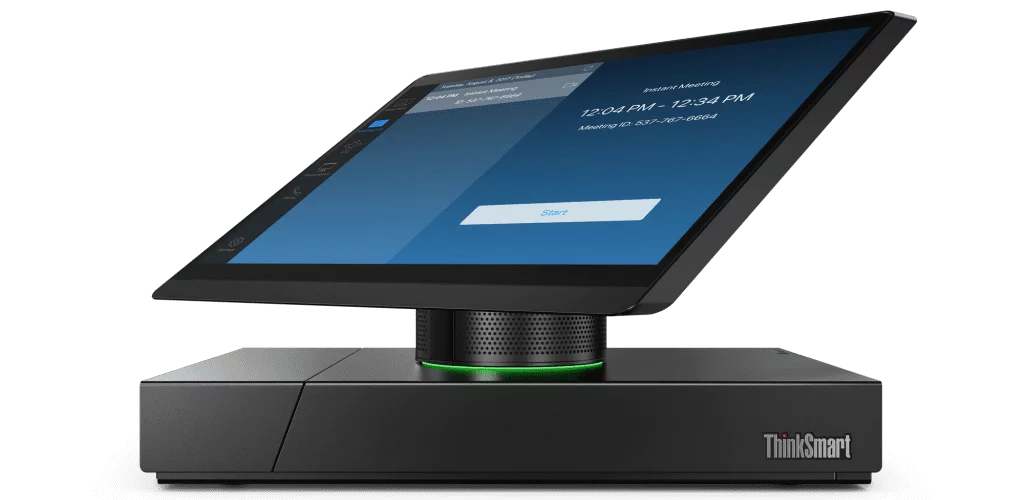“Hold on, let me try calling in with my mobile.”
“Sorry, the app is forcing an update before I can launch.”
“Can everyone see my screen? Can anyone see my screen?”
Then, via text: “Hey, will you let me in? I need some kind of password to join from my phone.”
“I thought we had this conference room reserved… are we even in the right building?”
All those videos lampooning conference calls can seem a bit too close to reality. Devices keep getting smarter, new technology blazes forward, and the Smart Internet of Things creates unprecedented connections. But meetings somehow often lag behind the latest optimizations and instead greet attendees with a series of stumbles.
It doesn’t have to be that way. In fact, Lenovo’s ThinkSmart Hub series is already transforming the experience. But consider those devices—including new Zoom compatibility—the first play in a long game, one that will push tech seamlessly into the background and empower human interaction.
“I see a world of interconnected technologies, where a trusted tech partner like Lenovo can offer hardware and software, smarter technology with built-in artificial intelligence to make more immediate human connections,” said Joseph Mingori, general manager, Lenovo Smart Office Business. “We are at the beginning of our journey, and the road ahead is very exciting.”
Lenovo is all-in on removing meeting malaise. To do that, designers and engineers must understand the underlying issues that lead to difficult, disjointed experiences. Essentially, the collaboration market has historically consisted of fragmented audio/video technologies and companies: independently created cameras, phones, software, meeting hubs, etc. That’s part of where the opportunity for innovation lies.
“We are uniquely capable of building hardware designed to work within our own smart ecosystem of devices, all while partnering with companies like Microsoft, Google, and Zoom to optimize software and integrate it natively into the devices,” Mingori said. “So we can break through that fragmentation and create a holistic solution.”
Cue the Hub 500 and the recent additions to the line, including interactive displays and AI-powered conference cameras. All these products emerged after listening to customer pain points and working to solve them.

Now, as companies continue to shift into open, flexible workspaces, the need for efficiency and flexibility has never been greater. So-called “huddle spaces,” where teams can collaborate quickly and painlessly in different ways, are on the rise. When a positive employee experience leads to greater productivity and performance, companies cannot compromise.
That drove the product team—including those focused on user experience—to work closely with Microsoft and build out the first Hub 500 to handle room telemetry, scheduling, microphone and speaker optimization, and much more at the press of a button. That was just the beginning.
“Last July we launched a new Smart Office business group,” Mingori said. “This is a real investment of time, resources, and overall strategy. We hired innovators in the meeting space, including software coders and hardware manufacturers, so we could ramp up operations quickly. We focused furiously on finding great industry talent. We know what we don’t know, and we brought in the right leadership to fill in every gap.”
The team emphasizes both enhancement and disruption, looking at ways to reimagine meetings and inspire passion or closely serve a company’s culture and ambitions.
“Seeing people come together in a huddle space or collaboration space—seeing these deployed at a company like Michelin or Microsoft—people come in and push one button and a videoconference starts,” Mingori said. “Just seeing people connect so easily is really amazing.”

Beyond the high-performing Hub 500 in the Microsoft Teams market, Lenovo will roll out a dynamic, expanded portfolio in 2020 and beyond—including pro services, ThinkSmart software, Zoom devices and kits, and IoT-driven people & space finders.
“These new solutions will greatly expand our market scope in the overall Smart Office landscape,” Mingori said. “Our partners, analysts, and customers that have been fully briefed on our overall strategy are very supportive and excited. Enhancing employee experience, productivity, and improving collaboration via smarter intersected technologies is foundational for our innovation goals in the Smart Office business.”
